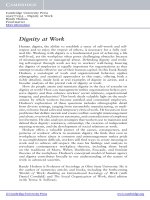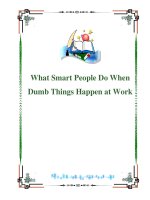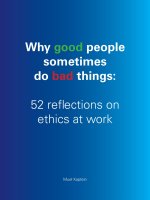Play at Work: How games inspire breakthrough thinking
Bạn đang xem bản rút gọn của tài liệu. Xem và tải ngay bản đầy đủ của tài liệu tại đây (2.21 MB, 256 trang )
PORTFOLIO / PENGUIN
Published by the Penguin Group
Penguin Group (USA), 375 Hudson Street,
New York, New York 10014, USA
USA | Canada | UK | Ireland | Australia | New Zealand | India | South Africa | China
Penguin Books Ltd, Registered Offices: 80 Strand, London WC2R 0RL, England
For more information about the Penguin Group visit penguin.com
Copyright © Adam Penenberg, 2013
All rights reserved. No part of this book may be reproduced, scanned, or distributed in any printed
or electronic form without permission. Please do not participate in or encourage piracy of copy-
righted materials in violation of the author’s rights. Purchase only authorized editions.
ISBN 978-1-101-62302-2
FOR THE PENENGIRLS:
Charlotte, Lila, and Sophie
CONTENTS
Title Page
Copyright
Dedication
Introduction
PART I
GAMEFUL DESIGN
CHAPTER 1
This Is Your Brain on Games
CHAPTER 2
Mass Organizer
CHAPTER 3
The Red Balloon Game
CHAPTER 4
The Wisdom of Cars
CHAPTER 5
Anyone Can Be an Inventor
PART II
SERIOUS PLAY
CHAPTER 6
That’s Edutainment!
CHAPTER 7
Wii-hab
CHAPTER 8
Blinded Me with Science
CHAPTER 9
Med-Sims
PART III
GAMES AT WORK
CHAPTER 10
New World Order
CHAPTER 11
Customer Feedback Loops
CHAPTER 12
The Bug Tester
Conclusion
Acknowledgments
Notes
Index
6/256
INTRODUCTION
O
ver the years, Ian Bogost has developed a colorful palette of inter-
active games, although probably not the kind you’re accustomed to
playing. As a game designer and professor of digital media and in-
teractive computing at the Georgia Institute of Technology, Bogost is the an-
tithesis to profit-hungry entertainment behemoths such as Electronic Arts,
creating games as a mode of expression for social, political, and artistic com-
mentary, and not so much for commercial gain.
For instance, in Jetset, which Bogost released through his company, Per-
suasive Games, a player assumes the role of TSA screeners at an airport and
deals with angry passengers and ever-more-complicated rules (shirts are
banned, then cell phones) until the line grinds to a halt and he’s fired. Si-
mony, rendered predominately in Latin, is a combination art installation and
iPhone/iPad game that addresses “the role of belief and religion in a techno-
logical, secular world.” Bogost has released games that feature snippy
Kinko’s employees serving irate customers, tomato growers confronting E.
coli outbreaks, and dieters forced to manage their menus on ever-leaner
budgets. The ingenious Oil God seeks to explore the ties that bind geopolit-
ics, gas prices, and oil profits. “Wreak havoc on the world’s oil supplies by
unleashing war and disaster,” reads the promotional copy that Bogost
penned. “Bend governments and economies to your will to alter trade prac-
tices. Your goal? Double consumer gasoline prices in five years using
whatever means necessary: start wars, overthrow leaders, spawn natural dis-
asters—even beckon the assistance of extraterrestrial overlords.”
Given his approach to game design, you shouldn’t be surprised to learn
that Bogost despises “gamification”: the integration of gamelike elements in-
to nongame activities. The way he sees it, over the past few years gamifica-
tion has become the “it girl” of business, spawning conferences and a hefty
dose of me-too-ism as some companies, eager to embrace it, tack on points
or badges to just about any mundane activity to trick employees into think-
ing it’s actually fun. That way they’ll complete it more quickly and efficiently.
Meanwhile, marketers use it in an attempt to get us to buy more stuff. Think
Tropicana, which tried rewarding frequent orange juice drinkers with re-
deemable points. You might call that lame-ification.
Bogost dismisses gamification as “exploitationware,” a “grifter’s game,
pursued to capitalize on a cultural moment,” and “to bring about results
meant to last only long enough to pad [gamification proponents’] bank ac-
counts” before the next trend comes along. It “gives Vice Presidents and
Brand Managers comfort: they’re doing everything right, and they can do
even better by adding ‘a games strategy’ to their existing products, slathering
on ‘gaminess’ like aioli on ciabatta at the consultant’s indulgent sales lunch.”
The mellifluously acerbic Bogost also aims his ire at social game makers
such as Zynga, which he dubbed “the Wall Street hedge-fund guys of games”
for its purveyance of uncreative, unchallenging experiences. Bogost’s own
games also have players engage in uncreative, unchallenging work and game
play, too, but that’s precisely his point. He views them as tools to educate, to
show players how the other half lives, to embrace the mundane and “disrupt
and change fundamental attitudes and beliefs about the world, leading to
potentially-significant long-term social change.” His videographic work, like
Jetset and Oil God, are more performance art than commercial product, and
few outside a cadre of gamesian academics have actually played them. But
that changed when Bogost shined his critical klieg lights on Zynga’s Farm-
ville, which requires players to return over and over to water plants that
would otherwise die. Bogost “feared” this “behaviorist experiment with rats,”
as he told CNET, arguing that Zynga’s designers were exploiting people’s
compulsions. If there were a deeper, more critical artistic or social aspect to
Zynga’s games, that would be one thing. Bogost found it maddening that the
company was simply in it for the money.
On his blog he railed against the whole idea of social games, where
“friends aren’t really friends; they are mere resources,” and “not just re-
sources for the player, but also for the game developer, who relies on insipid,
‘viral’ aspects of a design to make a system replicate.” The makers of these
games “build compulsion into their design” and “the play acts themselves are
rote.” If a player gets stuck, he can buy his way to the next level. What’s
worse, “Social games so covet our time that they abuse us while we are away
8/256
from them, through obligation, worry, and dread over missed opportunities.”
They not only waste our time when we play them, “they also destroy the time
we spend away from them.”
Instead of merely talking about it, though, Bogost decided to make a
statement with a satire that would deploy the same inane, albeit addictive,
hooks as Farmville. The result: Cow Clicker, a Facebook game he unveiled at
a “Social Games on Trial” seminar held at NYU in 2010.
I’ll let Bogost describe it:
It’s a Facebook game about Facebook games. It’s partly a satire,
and partly a playable theory of today’s social games, and partly an
earnest example of that genre. You get a cow. You can click on it.
In six hours, you can click it again. Clicking earns you clicks. You
can buy custom “premium” cows through micropayments (the
Cow Clicker currency is called “mooney”), and you can buy your
way out of the time delay by spending it. You can publish feed
stories about clicking your cow, and you can click friends’ cow
clicks in their feed stories. Cow Clicker is Facebook games dis-
tilled to their essence.
Bogost made Cow Clicker extra social by allowing each player to invite
eight others to join his pasture, and whenever someone clicked on a cow,
everybody would receive a point (adding incentive, savvy that?). A leader-
board tracked the clickiest cow clickers.
Then something remarkable happened. His parody of a game became a
hit. It started with those in on the joke playing for the love of irony, but
quickly spread well beyond. Soon tens of thousands of players were fever-
ishly clicking on Bogost’s bovines, and most weren’t in on the joke. Perhaps
he shouldn’t have been surprised. He had intended Cow Clicker to ape
Farmville—inane, insipid, insultingly easy—except his was a practical joke
made at the expense of its players, while Zynga’s designers produced theirs
for commercial gain. Their ends might have diverged, but their means didn’t.
While disturbed by the success of Cow Clicker, Bogost, like any good de-
signer, added features to keep players hooked. He introduced “mooney,” a
virtual game currency that users could purchase with Facebook credits,
which they in turn bought with real money. (The micropayment exchange
rate: 125 mooney = 10 Facebook credits = $1.) This allowed them to purchase
9/256
Steel Cow (a bargain at 10 mooney); Oil Cow (200 mooney), which was
slathered in petroleum and sported a BP-like emblem; Bacon Cow (200
mooney), exactly as it sounds; Mao Cow (500 mooney); and a herd of others.
Then, to really mess with his users, he created special-issue cows at obscene
prices. There was Bling Cow, which ran 10,000 mooney, or a cool $80. Many
paid, though some became alienated. The introduction of Stargazer Cow,
which was identical to the standard-issue cow except it was turned the other
direction and priced cynically at 2,500 mooneys (or $20), drove 8,000 irate
players (16 percent of his playing base) to quit the game in one day. Bogost
couldn’t have cared less.
To poke fun at the idea of “clicktivism,” the term coined to describe what
Bogost views as an inherently lazy expression of online political activism
when a user chooses to like or follow a cause or person, he partnered with
Oxfam America. On a special page called “Cow Clicktivism” (“Click your cow.
Change the World.”), players could transform virtual cows into real cows by
taking part in click-ins every six hours, with Bogost promising to donate a
real cow to Oxfam if enough people clicked. He also offered for sale a special-
edition Cowclicktivist Cow (sad-faced, skinny, ribs showing, ears sagging) for
$110. In the end, he raised more than $1,125, or enough to donate fifteen
real-life, mooing cows.
In Bogost’s view, Cow Clicker “distilled social games to their essence, of-
fering players incentive to instrumentalize their friendships, obsess over ar-
bitrary timed events, buy their way out of challenge and effort, and incre-
mentally blight their offline lives through worry and dread.” Nevertheless, he
layered in more features. Some were conceived to juice the game’s virality by
awarding mooneys to those who clicked on clicks announced by players in
Facebook’s news feed. Others played on the idea of badges, like his awarding
the Golden Cowbell to players who hit 100,000 clicks. Still others added an
element of chance by letting players randomly win or lose money on each
click. He sold Cow Clicker T-shirts, hoodies, commemorative mugs, and car
decals. Still, people bought and Bogost made money.
His friend and Gamasutra columnist Leigh Alexander noticed a change
had come over Cow Clicker’s creator, as his joke, which took him a grand
total of three days to create, surpassed in popularity all the other projects on
which he had lavished attention. Bogost had entered a “no-win spiral,” she
wrote, “taking on the aura of a mad scientist, making triumphant
10/256
declarations over equations that were comprehensible only to him and to his
inexplicably entrenched players, now indistinguishable from his fellow satir-
ists.” He was hooked on administering the game he had created as a satire on
the inanity and addictiveness of social games. Bogost also recognized these
dangers. “Just like playing one, running a game as a service is a prison one
may never escape.”
Six months after Cow Clicker’s release, Bogost launched, with some fan-
fare, cowclickification, his not-so-veiled swipe at gamification, which he
defined as “the application of cow-clicking mechanics to non-cow-clicking
applications.” Businesses, he boasted, could “employ new cow-clicking
mechanics such as clicking a cow to distract customers from the vapid point-
lessness of their products and services.” Then there was Cow Clicker Con-
nect, which allowed Web sites to embed cow-click buttons. “Think about it,”
Bogost wrote: “would you rather order a pizza, submit a comment, or rate an
escort service by clicking a boring button . . . or by clicking your cow?” He
churned out a sister game (Cow Clicker Blitz), a search engine (Moogle), and
a mobile app (“Cow Clicker Moobile”) that you could buy in “The Stock-
yard”—the Cow Clicker app store.
When he was finally ready to wind down the game, Bogost introduced a
clock counting down to its end but with an ingenious Zynga-like twist: each
time a player clicked a cow time ran off the clock, but Bogost also let players
pay $1 for an additional hour (or $400 for a month). Some eleventh-hour re-
mittances delayed but could not postpone the inevitable “rapture.” When the
clock struck zero, Bogost unleashed the Cowpocalypse, and all the cows
“were raptured to their heavenly pastures,” even the ones players spent
money on. The game continued to live on with eerily empty pastures. Players
could still click where cows used to be and possibly earn a Diamond Cowbell
award if they achieved one million clicks. “In so doing,” Bogost signed off,
“the game has perhaps reached its maximum level of minimalism, although
it’s clear that nobody is clicking empty space, but rather they are clicking the
memory of where a cow once nobly stood.”
For his part, Bogost told Wired he wasn’t sure whether Cow Clickers rep-
resented his greatest success or a colossal failure. All these people clicking on
cows. What did it mean? He wasn’t sure.
11/256
What it does show is that games and game mechanics can be, if designed
intelligently, a powerful way to drive engagement, something that even gami-
fication’s most ardent critics would have to agree with.
The Game Layer
Look around. Games are everywhere. Start with that carton of orange juice in
your fridge, which might advertise it’s worth three points, redeemable for
discounts and prizes. It’s a game. What about frequent-flier miles, which are
games that reward loyalty? Mega Millions, Powerball, Take Five, and other
state lotteries? Games. Nissan has an in-car gaming system that encourages
drivers to compete for best efficiency levels (Bronze, Silver, Gold, and Platin-
um). Talk about a mobile game. You could look at Twitter as a game, the pay-
off being more and more followers and greater numbers of retweets the more
you use it. Peer at the gamelike iconography of your iPhone and you might
recognize it as reminiscent of old video games like Pac-Man and Space In-
vaders. The next time you go to Target notice the checkout screen. On it
you’ll see a game that rates the cashier’s speed. According to one report, Tar-
get maintains a running average of an employee’s scores, requiring that more
than 88 percent of transactions make the speed cut, with a cashier’s score af-
fecting salary and promotions. Target has turned cashiers into players of a
corporate game. In some urinals men may see a fly stuck on the bottom, a
game mechanic put there to steady their aim (and keep restrooms cleaner).
The term “Baader-Meinhof” describes that feeling you get when you hear
or read a word you’ve never encountered before then subsequently notice it
all around you. It’s born of our brains’ tendency to filter out uninteresting in-
formation until it isn’t uninteresting anymore. (If you think about it, the first
time you read “Baader-Meinhof” may be to experience Baader-Meinhof.)
This is what may happen when you begin to notice all the games—and their
corresponding gamelike elements—that surround you. That’s because games
(or at least the characteristics of games) have been creeping into almost
every facet of our lives. Some refer to it as the “game layer.”
Because games are about players achieving goals while having fun—a very
powerful, very human drive—an array of companies such as Google, Mi-
crosoft, Cisco, Deloitte, Sun Microsystems, IBM, L’Oreal, Canon, Lexus,
12/256
FedEx, UPS, Wells Fargo, and countless others have embraced them to make
workers more satisfied, better trained, and more focused on their jobs, as
well as to improve products and services. Google and Microsoft have created
games to increase worker morale, quality control, and productivity. At
Google, engineers have been able to spend an in-house currency called
“Goobles” on server time—often a scarce resource at Google—or use it to bet
on certain outcomes as part of a company-wide predictions market. The
Brobdingnagian search engine has also gamified its expense system. If an
employee spends less on an airline ticket than he has been allotted, the sav-
ings can be donated to a charity of the worker’s choice. Microsoft released a
game, Ribbon Hero, to teach users how to make better use of its Microsoft
Office software and has experimented with games in its workplace.
Canon’s repair techies learn their trade by dragging and dropping parts
into place on a virtual copier. Cisco has developed a “sim” called myPlanNet,
in which players become CEOs of service providers, and adopted gaming
strategies to enhance its virtual global sales meeting and call center, lessen-
ing call time by 15 percent and improving sales between 8 percent and 12
percent. IBM created a game that has players run whole cities. L’Oréal cre-
ated games for recruitment, for gauging the skills of potential employees and
helping them discover where in the corporation they would most like to
work. Sun Microsystems has games for employee training. Meanwhile,
Japanese automaker Lexus safety tests vehicles in what it brags is the world’s
most sophisticated driving simulator at its Toyota research campus in Japan.
FedEx and airlines deploy game simulations to train pilots, and UPS has its
own version for new drivers—one even mimics the experience of walking on
ice.
We can trace the term “gamification” to 2002, when Nick Pelling, a young
British video game designer, started Conundra, a consulting firm that com-
bined game mechanics with business strategy. Alas, he was too early, and his
consultancy didn’t last. Over the past few years an entire industry has
sprouted up around gamification—the very thing that Ian Bogost detests.
The Entertainment Software Association estimates that 70 percent of major
employers use interactive software and games for training. Research firm
Gartner projects that by 2014, 70 percent of two thousand global organiza-
tions will depend on gamified applications for employee performance, health
13/256
care, marketing, and training, and 50 percent of corporate innovation will be
gamified, with American corporations spending several billion dollars on it.
Companies like Badgeville, based in Redwood City and backed by forty
million dollars in venture capital, boasts hundreds of Global 2000 busi-
nesses as customers. Wells Fargo uses Badgeville for customer and employee
engagement, Chevron depends on it for juicing worker collaboration, GE de-
ploys it on its sales team, while Deloitte reports that training programs that
have been gamified take workers half the time to complete than traditional
ones while concurrently improving attention span. With Badgeville, Cours-
era, the online education company, reports more activities per student per
week, higher grade point averages, far fewer failures, and a significantly
higher retention rate. After Samsung layered Badgeville over its Samsung
Nation online community with its hundreds of thousands of members, the
number of product reviews quintupled and four times as many people
leveled up to being “advocates”—those identified as spending ten times as
much on Samsung products as regular consumers.
“I think of gamification as music that you listen to when you run,” Kris
Duggan, Badgeville’s founder and chief strategy officer, says. “It’s more fun
with music.”
Games are proving good for business. Popchips’ sales increased 40 per-
cent to more than a hundred million dollars after the company created mo-
bile games designed to overcome users’ resistance to mobile ads, and Bell
Media increased customer retention by 33 percent after introducing “social
loyalty” rewards on its Web site. Games are contributing to a healthier work-
force: NextJump tasks games with helping to induce employees to hit the
gym more often, while AETNA uses Mindbloom’s Life Game to encourage
customers and employees to adopt healthier habits. Gamification may even
be good for the environment. SAP created a game to encourage workers to
carpool to cut down the company’s carbon footprint, while RecycleBank and
OpowerL increased recycling 20 percent.
Naturally, business isn’t alone in embracing games. The military has been
leading the charge into 3-D virtual worlds and experimenting with video
games since 1997, when the marines adopted Doom, the game that popular-
ized the first-person shooter, which it purchased for $49.95, then modified
by changing demons into Nazi soldiers firing M-16s. The army budgeted fifty
million dollars to develop gaming systems, applying simulations to
14/256
everything from recruitment to training soldiers in fixing tanks, using satel-
lite feeds, piloting drones and aircraft, and full-out combat missions. Now
“militainment” is a state-of-the-training methodology—perfect for young
men and women who have already mastered the art of simulated war.
And why not? Army life often imitates art. Operating the gunnery on a
tank or firing missiles from a naval destroyer resembles a first-person shoot-
er game, while piloting a predator drone over Pakistan from the comfort of a
computer nine thousand miles away is a skill that brings to mind Missile
Command, a star of the 1980s arcade. Lockheed Martin manufactured Virtu-
al Combat Convoy Trainer, a system in which soldiers who shipped out to
Afghanistan simulated battles over the same terrain and even the same
streets as the ones they would patrol, grappling with everything from impro-
vised explosive devices to snipers to suicide bombers, and was awarded a
$146 million government contract to develop a war-game training system for
U.S. and allied commanders.
It’s perhaps telling that the army’s most successful recruitment tool is a
first-person-shooter game called America’s Army, in which players get
points for blowing up enemy combatants. One study concluded that the
game has done more to influence recruits “than all other forms of army ad-
vertising combined,” with “30 percent of all Americans aged 16 to 24 having
a more positive impression of the Army because of the game.” Extremely
popular—more than seven million people, including 40 percent of new en-
listees, have played the game since its 2002 release—it’s also cost effective:
America’s Army cost six million dollars to create and the Web site is a mere
four thousand dollars a year to maintain.
Three-lettered agencies like the CIA, FBI, NSA, and DoD use games to
train agents in antiterrorism. The Defense Intelligence Agency (DIA) trains
spies with PC-based games such as Sudden Thrust, written by David Freed, a
B-list television writer. Sudden Thrust players take on the role of a DIA ana-
lyst confronting terrorists who have hijacked a tanker brimming with natural
gas and steer it into New York Harbor. The CIA has commissioned the cre-
ation of video games to help train agents in counterterror techniques. Mean-
while the FBI uses Microsoft’s Xbox in the classroom to show trainees how to
plan and execute an arrest and secure crime scenes.
Games have been popping up at rehab facilities and encouraging people
to adopt healthier lifestyles. Doctors practice cutting open avatars instead of
15/256
cadavers before turning to living, breathing humans and perform surgeries
in completely simulated environments. Game design has even been changing
how we educate our kids, with the mechanics that make games so irresistible
retrofitted into curricula and layered into students’ classroom experiences.
While the last decade witnessed the rise of the social Web, establishing the
online framework for how we connect with one another, the next ten years
will usher in the era of game design and carry with it a pervasive net of
behavior-altering mechanisms.
On some levels this shouldn’t be surprising. A large percentage of Amer-
icans have been reared on games and it’s only fitting that something that has
profoundly shaped our connections to the world would be transposed to oth-
er aspects of our lives. Today, about 97 percent of twelve-to-seventeen-year-
olds play computer games, and so do almost 70 percent of the heads of
American households, says the Entertainment Software Association. One
survey found that 35 percent of C-suite executives play video games. Before
turning twenty-one, the average American has spent two thousand to three
thousand hours reading books—and more than three times that playing com-
puter and video games. You could argue that this much game play makes
them experts, if you buy the theories of Dr. Anders Ericsson (popularized by
Malcolm Gladwell in his book Outliers) on the value of ten thousand hours of
deliberate practice. Globally, 350 million people spend a combined three bil-
lion hours per week playing these games. PricewaterhouseCoopers estimates
that global sales of video games will grow from 2007’s $41.9 billion to $68.4
billion in 2012, when they will exceed the combined global revenues of film
box office and DVDs.
The massive multiplayer online game World of Warcraft boasted at its
peak twelve million registered users paying fifteen dollars a month to spend
an average of eighty hours per month inside the game. Since the game’s re-
lease in 2004, users have racked up more than fifty billion hours of playing
time—the equivalent of 5.93 million years. Game designer Jane McGonigal,
author of Reality Is Broken, points out that 5.93 million years ago is when
early primates began to walk upright. “We’ve spent as much time playing
World of Warcraft as we’ve spent evolving as a species,” she notes.
Play at Work is not about games per se. It is about harnessing the char-
acteristics that make them so engaging and applying them to other aspects of
our lives. These game mechanics can be applied to the workplace to make
16/256
employees happier, more productive and motivated, to increase company
profits and improve worker safety, to market new products, and to help with
customer service. They can help people learn and better retain information,
to create new products and solve big problems. And they can foster healthier
lives. Because they are predicated on providing a system of principles, mech-
anisms, and rules that govern a system of rewards that lead to a set of pre-
dictable outcomes, they can ratchet up a person’s engagement, and increase
happiness and productivity, which in turn can pay big dividends.
There’s a real need for this. Unhappiness in the workplace is endemic
across all generations, even though, as Shawn Anchor, a Harvard professor
and author of The Happiness Advantage, points out, “Nearly every company
in the world gives lip service to the idea that ‘our people are our greatest as-
set.’” The Conference Board, a private economic think tank in New York,
found in a 2010 survey that only 45 percent of American workers were satis-
fied with their jobs, down from 49 percent two years earlier. Contrast that
with the Conference Board’s first survey, conducted in 1987, when 61 percent
of workers reported being happy with their work. One reason: only half
found their jobs interesting, another low in the survey’s twenty-two-year his-
tory, and the same percentage were satisfied with their bosses, while in 1987
almost 70 percent found their work interesting. The youngest work-
ers—those twenty-five and under—claimed the highest levels of dissatisfac-
tion, with 64 percent unhappy with their duties.
Mercer’s What’s Working survey in 2011 reported that 32 percent of
workers were seriously considering leaving their jobs, with several factors
contributing to the malaise. Workers cited a lack of fair treatment as the
most important reason, followed by “work/life balance, type of work, quality
of co-workers and quality of leadership.” Base pay ranked only sixth. A Gal-
lup poll that same year found that 71 percent of American workers are “not
engaged” or “actively disengaged” in their work, and highly educated workers
are the least engaged. This is all the more disturbing because, as Gallup
notes, engaged employees are more productive, more profitable, more
customer-focused, safer, and more likely to remain with their employer.
They are also healthier, with workers who are emotionally disconnected from
their work about as likely as the unemployed to report suffering from chronic
illnesses, obesity, diabetes, and high blood pressure and cholesterol. Further,
“actively disengaged employees erode an organization’s bottom line while
17/256
breaking the spirits of colleagues in the process,” according to Gallup, which
estimates that this costs the American economy more than three hundred
billion dollars in lost productivity alone.
Play at Work shows how to combat this abject negativity, which compan-
ies, educators, heath care practitioners, and individuals ignore at their own
peril. It illustrates how businesses from the smallest start-ups to nonprofit
organizations to schools to government agencies and the biggest multina-
tional corporations are unleashing gameful design—the characteristics that
make games fun and addictive—to increase worker productivity and job sat-
isfaction, train employees, get them to communicate better and interact
more, incent them to be more environmentally conscious, and contribute to
the creative process. It addresses how individuals can adopt games to rehab-
ilitate serious injuries, to gin up motivation and help them conquer neces-
sary tasks, to get fitter and stronger, lose weight, get smarter. It peers into
the brain and sheds a light on our biochemistry at the instant total engage-
ment is achieved, and considers strategies to mimic this state of mind in the
workplace and beyond. It addresses simulations as training tools for sur-
geons, and looks at ways game design is transforming education.
While games are a powerful mechanism in triggering rapt engagement,
they aren’t the only way. Communities often coalesce around shared in-
terests, and the book looks at several instances where passion for a hobby
has been redirected to help solve big problems in science by tapping the
combined force of thousands of people or cocreating products from their ini-
tial inspiration through the design process to manufacturing and beyond.
With the right approach, it’s even possible to harness short bursts of
drudgery—such as the security protocol that hundreds of thousands of Web
sites have adopted that has you retype fuzzy letters into a box so the com-
puter knows you’re not a spambot—and transform it into something that be-
nefits mankind.
Play at Work is divided into three parts. “Gameful Design” focuses on the
process of tapping game mechanics and fostering our natural inclination to
play to organize massive numbers of people to solve big problems. It intro-
duces a MacArthur “genius” grant recipient who specializes in combining
vast computing power with human intelligence, retrofitting a security pre-
caution used by millions of people to stamp out fraud in online purchases to
clean up thousands of articles in the New York Times digital archive going
18/256
back to 1850, as well as millions of pages of old books and maps, and his au-
dacious plan to translate the entire Internet. It takes you into DARPA’s
headquarters to learn about experiments the agency has instituted to organ-
ize large groups of people to locate hard-to-spot clues and come up with bet-
ter combat tactics. It offers a bird’s-eye view of a factory in Phoenix, Arizona,
where designs for cars and trucks are “cocreated” by a community of fifteen
thousand gearheads. It recounts how one company taps the power of game
mechanics to foster competition and lead regular people to post ideas for
simple inventions that are collectively designed by thousands of contribut-
ors, as well as professional designers, before being brought to market and
sold at major retailers such as Target.
“Serious Play” looks at using games to solve big problems. It searches for
a workable definition of what a game is, analyzes the mechanic that make
them engaging, and shows how our brains react when we play them. It looks
at ways that “pleasure technologies” (movies, music, and video games) hack
our brains by triggering innate reward systems. It explores how educators
are increasingly using games to engage hard-to-reach students and the Wii
as a staple in rehabilitation (so much so it’s been dubbed “Wii-hab”). It pro-
files a game designer who works with nonprofits to code serious games to
promote exercise, help diabetics make healthy food choices, and remind
preteen and teenage HIV carriers to take their medications. It relates how
games are being used in scientific discovery, helping researchers in ways that
few could have imagined. It examines the use of simulations and lifelike
mannequins in medical training, leading you on a guided tour of a six-
million-dollar simulation center used for preparing surgeons and health-care
professionals for surgery and medical emergencies.
“Games at Work” describes the integration of gamelike mechanics and
dynamics to improve business processes, customer experience, and the
workplace. It traces the explosion of social media coupled with the expansion
of mobile technology and how it is altering the relationship between con-
sumers and products, and what this means for tomorrow’s companies. It
checks into the use of game mechanics in restaurants to improve service and
the gamification of virtual call centers, predicting the call center of the fu-
ture, where operators may operate inside video games. It takes you to Mi-
crosoft’s main campus in Bellevue, Washington, to see how one man has
been introducing games into the workplace to confront a generational divide
19/256
that every business faces, improve bug testing and quality control, and in the
process increase worker satisfaction and lessen attrition.
While Play at Work looks at some of the wonderful ways that games can
help us, it is not a paean. Games are not a panacea to everything that ails us.
After all, someone has to pick up trash off the streets and unclog sewage
pipes, and it’s doubtful that games could make these pleasurable activities.
Nor are they likely, despite what some game-design boosters claim, to offer
the path to a solution to problems like nuclear proliferation. To quote Gabe
Zichermann, author of Gamification by Design and Chair of the Gamifica-
tion Summit: “Game mechanics cannot solve fundamental business prob-
lems. It will not rebuild poor infrastructure, nor will it heal disastrous cus-
tomer service.”
But intelligent use of game mechanics can help us achieve great things,
and that is what this book is about.
20/256
PART I
GAMEFUL DESIGN
In a memorable scene in Mark Twain’s Adventures of Tom Sawyer, Tom’s
aunt orders him to whitewash a fence as punishment for playing hooky. He
doesn’t relish this, so, ingenious boy that he is, he tricks several children to
do the job for him by convincing them the task is so enjoyable that he doesn’t
want their help. The boys beg him to let them take over—they even pay him
with twelve marbles, a chunk of blue bottle glass to look through, a kite, a
key that wouldn’t unlock anything, and a dead rat he could swing from a
string.
Tom, Twain wrote:
had discovered a great law of human action, without knowing
it—namely, that in order to make a man or a boy covet a thing, it
is only necessary to make the thing difficult to attain. If he had
been a great and wise philosopher, like the writer of this book, he
would now have comprehended that Work consists of whatever a
body is obliged to do, and that Play consists of whatever a body is
not obliged to do. And this would help him to understand why
constructing artificial flowers or performing on a treadmill is
work, while rolling ten-pins or climbing Mont Blanc is only
amusement. There are wealthy gentlemen in England who drive
four-horse passenger-coaches twenty or thirty miles on a daily
line, in the summer, because the privilege costs them considerable
money; but if they were offered wages for the service, that would
turn it into work and then they would resign.
If Tom had money, he might have tried to buy his way out of his plight. In
other words, he could have proffered what are known as “extrinsic rewards,”
that is, tangible benefits. In the workplace these are usually manifested as
bonuses or a raise in pay. Although Tom Sawyer’s friends would likely have
been pleased to receive some extra cash, their hearts wouldn’t have been in
the task at hand. Instead, Tom served up “intrinsic rewards” by convincing
the children that whitewashing a fence was fun. Suddenly something they
viewed as drudgery was transformed into a raucous party. Not only were
they willing to take over painting the fence, they insisted, and the fence got
whitewashed faster than if Tom had worked alone.
Tom was deploying a secret weapon: gameful design. On her blog, Chelsea
Howe, an independent game designer who once worked at Zynga, believes
that gameful design “helps you do what you want to do.” As with Tom Saw-
yer’s friends, “No one is telling you to play, no one is giving you money to
play, no one is holding a gun to your head making you play,” she told me.
“You’re intrinsically motivated.” Even failing is a virtue—and that happens
between 70 percent to 90 percent of the time. Yet they don’t put the game
down, they try harder. “But we love failing and love knowing that all that’s
holding us back is learning the system better,” she says. “Learn what not to
do, learn how to do the good things better, learn how to master the environ-
ments so you can get through it quicker, learn more about the people that
you are up against so that you can do better against them. It’s just a matter of
effort and time and skill and harnessing your mental energy and attention.”
Tapping into our innate desire to learn can aid all sorts of big-picture en-
terprises—harnessing the drive and determination of massive numbers of
people through judicious use of gamelike characteristics, which, with the aid
of gameful design, can help solve big problems. In some instances, the by-
product of playing a game or engaging in an action yields something benefi-
cial. In others it’s merely taking an activity that people already engage in and
incenting their behavior with gamelike properties. The key, Howe says, is re-
cognizing that “play is learning.” When we play a game, “we learn its system,
and the fun of the game is actually learning,” she says. “Once we’ve learned
the system, once we’ve mastered it, once we’ve finished the game, it becomes
‘unfun.’”
In this section on gameful design we’ll look at our brains and why they re-
spond so well to play, as well as learn about ways that marketers, movie
22/256
directors, and game designers hack our brains to induce us to do their bid-
ding. We’ll search for a workable definition of games, try to figure out what
makes a game good, and differentiate between games and game mechanics.
We’ll visit with a man who combines the best of what humans and computers
do well to organize millions of people to achieve great things, check out an
automobile factory outside of Phoenix, Arizona, that cocreates its flagship
product by combining the collective wisdom of thousands of car buffs with
professional car designers, and look at an entrepreneur who has designed an
intriguing crowd-based work flow to make invention accessible to all.
All of these rely on the organization of massive numbers of people, made
possible by the same game mechanics that enabled Tom Sawyer to persuade
his friends not only to whitewash the fence—for free—but to want to.
23/256
CHAPTER 1
THIS IS YOUR BRAIN ON
GAMES
I
first became interested in games and their use in nongaming environ-
ments after stumbling across a video of a speech by game designer
Jesse Schell, which he presented to a crowd of four hundred or so at-
tendees at the 2010 DICE (design, innovate, communicate, entertain) Sum-
mit, the video-game industry’s answer to TED. Organizers had invited the
forty-year-old game designer and Carnegie Mellon professor dressed in a
crinkly button-down shirt and chinos to share insights about his work at Dis-
ney Imagineering, where he had helped design large-scale theme-park rides
such as Pirates of the Caribbean. But “the Mouse” would have his head if he
violated any nondisclosure agreements, so the day before his speech, on the
flight from Pittsburgh to Las Vegas, he sketched out something radically dif-
ferent, which he titled “Beyond Facebook.” Later he changed it to “Design
Outside the Box.”
“There are all these ways that games are creeping into places we didn’t
think about,” he said. This was already happening, and the games were alter-
ing human behavior. What were American Express points and frequent-flier
miles but games that reward loyalty? Weight Watchers? A game with points.
Fantasy football? A game stacked on top of a game that “leeches off a game.”
In the Ford Fusion, there’s a game installed in the dashboard to incentivize
fuel economy. The more gas you save, the more the plant grows. “They put a
virtual pet in your car,” Schell said in his speech, “and it changes the way
people drive.”
Sensors have gotten so cheap they are being embedded in all sorts of
products. Pretty soon, every soda can and cereal box could have a built-in
CPU, screen, and camera, along with Wi-Fi connectivity. And at that point,
the gaming of life takes off. “You’ll get up in the morning to brush your teeth
and the toothbrush can sense that you’re brushing,” Schell said. “So, ‘Hey,
good job for you! Ten points’” from the toothpaste maker. You sit down to
breakfast and get ten points from Kellogg’s for eating your Corn Flakes, then
grab the bus because you get enviro-points from the government, which can
be used as a tax deduction. Get to work on time, your employer gives you
points. Drink Dr Pepper at lunch, points from the soda maker. Walk to a
meeting instead of grabbing the shuttle, points from your health-insurance
provider. Who knows how far this might go? Schell said.
He offered some pretty psychedelic scenarios, like one in which you recall
a dream from the previous night where your mother was dancing with a gi-
ant Pepsi can: “You remember the REM-tertainment system, which is this
thing you put in your ear that can sense when you enter REM sleep, and then
[it] starts putting little advertisements out there to try and influence your
dreams.” If the ads take hold, you win big points for discounts at your local
grocery store. “Then there’s your office mate,” Schell continued, “and he’s
like, ‘Check out this new digital tattoo’” that he got from Tatoogle AdSense,
and when you show him yours, you realize you’re both wearing Pop-Tart ads.
You get paid for the ads, plus thirty additional points just for noticing.
After work, you go shopping. Points. Your daughter gets good grades in
school and practices the piano? More points. You plop down on your sofa for
some television, and “it’s just points, points, points, points,” because eye
sensors ensure that you actually watch the ads. In the meantime, you chat
with other viewers, play games designed around the ads, and tally more
points. It’s crass commercialization run amok, Schell conceded, but “this
stuff is coming. Man, it’s gotta come. What’s going to stop it?”
The applause was nothing compared to the reception his speech received
online. The video went viral, downloaded millions of times. Om Malik,
founder of the blog GigaOM and an astute observer of all things tech, called
it “the most mind-blowing thing I’ve seen in a long, long time.” Others
viewed Schell’s prediction that in the near future we might collectively exist
in a giant Skinner box as abjectly sinister: “the most disturbing presentation
of the year” and a “tech nightmare” that would doom us to lead our lives
25/256









